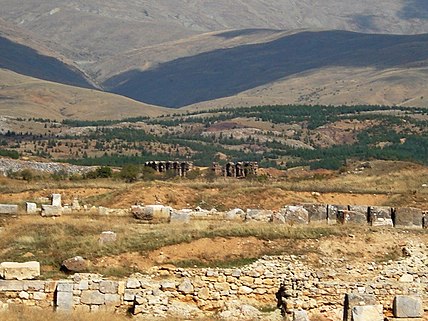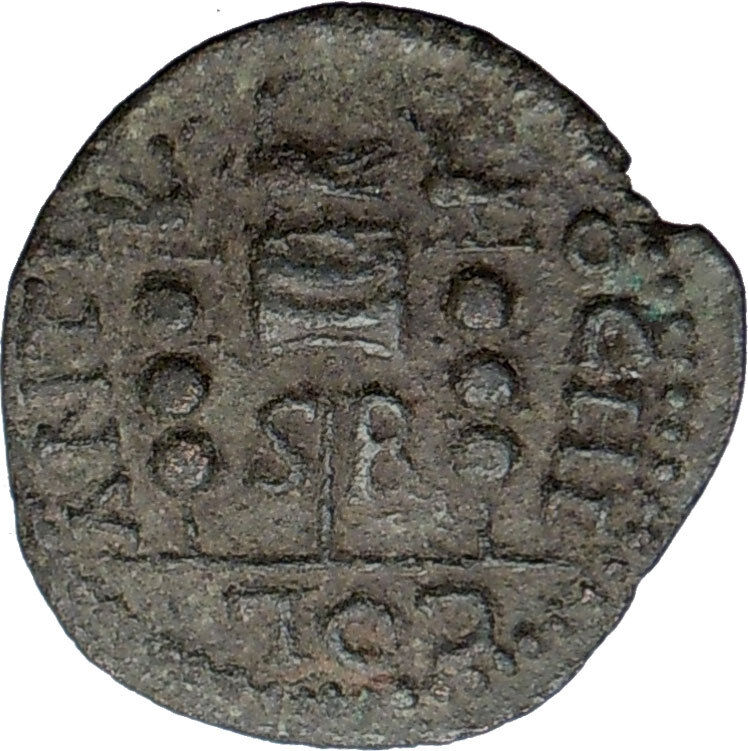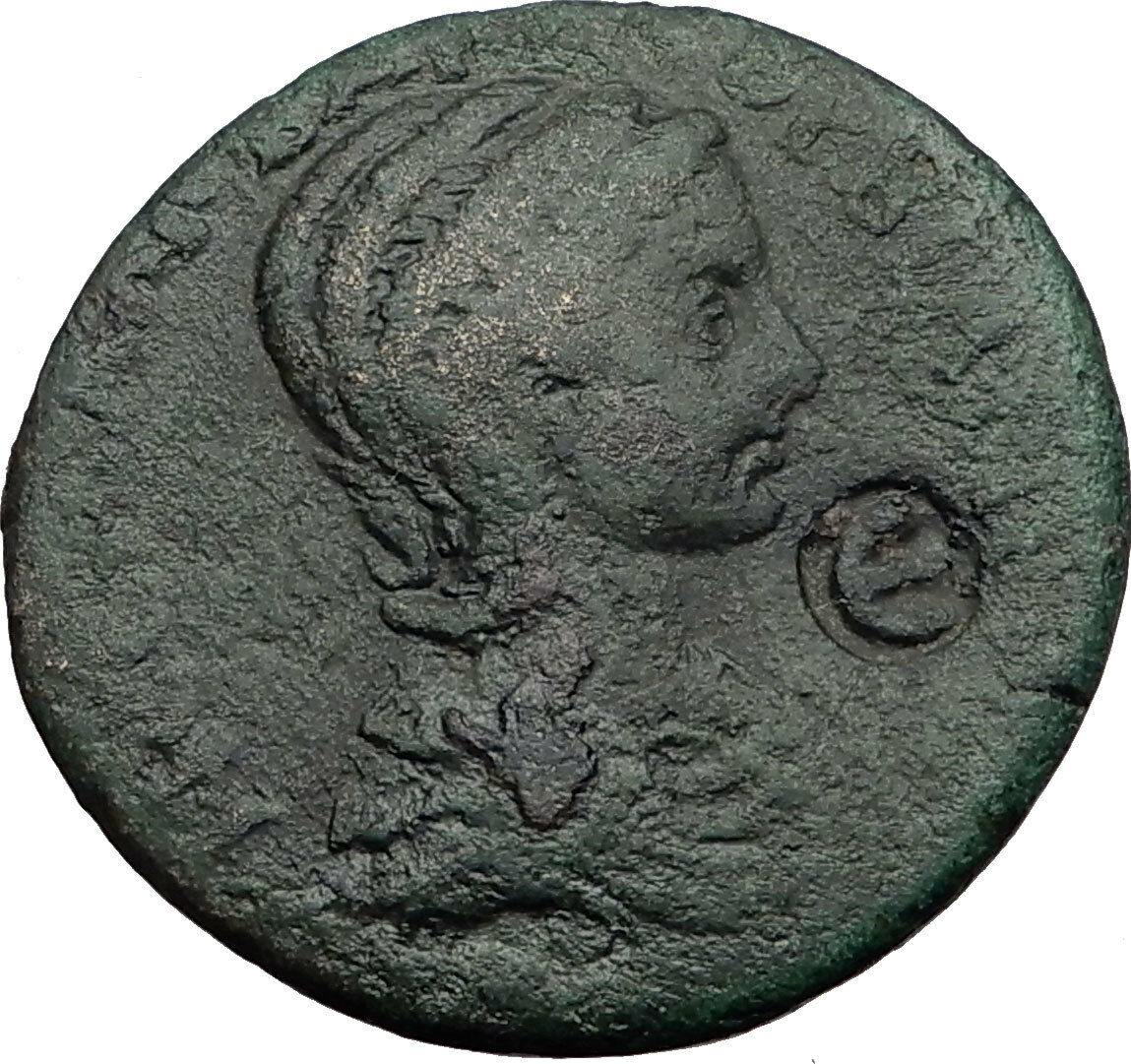|
Septimius Severus – Roman Emperor: 193-211 A.D.
Bronze 22mm (4.51 grams) of Antioch in Pisidia
Reference: SNG France 1113
SEVERVS PIVS AVG, Laureate head right.
ANTIOCH GENI COL CAE, Genius standing left, holding branch and cornucopia.
You are bidding on the exact item pictured, provided with a Certificate of Authenticity and Lifetime Guarantee of Authenticity.
The Genius was a protection spirit, analogous to the guardian angels invoked by the Church of Rome. The belief in such spirits existed in Greece and at Rome. The Greeks called them Daemons, and appear to have believed in them from the earliest times, though Homer does not mention them. Hesiod says that the Daemons were 30,000 in number, and that they dwelled on earth unseen by mortals, as the ministers of Zeus, and as the guardians of men and justice. He further conceives them to be the souls of the righteous men who lived in the golden age of the world. The Greek philosophers took up this idea, and developed a complete theory of daemons. Thus we read in Plato, that daemons are assinged to men at the moment of their birth, that they accompany men through life, and after death conduct their souls to Hades. Pindar, in several passages of the spirit watching over the fate of man from the hour of his birth. The daemons are further described as ministers and companions of the gods, who carry the prayers of men to the gods, and the gifts of the gods to men, and accordingly float in immense numbers in the space between heaven and earth. There was also a distinct class of daemons, who were exclusively the ministers of the gods.
The Romans seem to have received their notions respecting the genii from the Etruscans, though the name Genius itself is Latin (it is connected with gi-gn-o, gen-ui, and equivalent in meaning to generator or father). The genii of the Romans are the powers which produce life (dii genitales), and accompany man through it as his second or spiritual self. They were further not confined to man, but every living being, animal as well as man, and every place had its genius. Every human being at his birth obtained (sortitur) a genius, who he worshipped as sanctus et sanctissimus deus, especially on his birthday, with libations of wine, incense, and garlands of flowers. The bridal bed was sacred to the genius, on account of his connection with generation, and the bed itself was called lectus genialis. On other merry occasions, also , sacrifices were offered to the genius, and to indulge in merriment was not unfrequently expressed by genio indulgere, genium curare, or placarae. The whole body of the Roman people had its own genius, who is often seen represented on coins of Hadrian and Trajan. He was worshipped on sad as well as joyous occasions; thus, sacrifices were offered to him at the beginning of the 2nd year of the war with Hannibal. The genii are usually represented in works of art as winged beings. The genius of a place appears in the form of a serpent eating fruit placed before him.
 Antioch in Pisidia – alternatively Antiochia in Pisidia or Pisidian Antioch (Greek: Ἀντιόχεια τῆς Πισιδίας) and in Roman Empire, Latin: Antiochia Caesareia or Antiochia Caesarea – is a city in the Turkish Lakes Region, which is at the crossroads of the Mediterranean, Aegean and Central Anatolian regions, and formerly on the border of Pisidia and Phrygia, hence also known as Antiochia in Phrygia. The site lies approximately 1 km northeast of Yalvaç, the modern town of Isparta Province. The city is on a hill with its highest point of 1236 m in the north. Antioch in Pisidia – alternatively Antiochia in Pisidia or Pisidian Antioch (Greek: Ἀντιόχεια τῆς Πισιδίας) and in Roman Empire, Latin: Antiochia Caesareia or Antiochia Caesarea – is a city in the Turkish Lakes Region, which is at the crossroads of the Mediterranean, Aegean and Central Anatolian regions, and formerly on the border of Pisidia and Phrygia, hence also known as Antiochia in Phrygia. The site lies approximately 1 km northeast of Yalvaç, the modern town of Isparta Province. The city is on a hill with its highest point of 1236 m in the north.
Roman period
While the Hellenistic Kingdoms (the inheritors of Alexander the Great) were fighting each other and the Galatians, Rome became the most powerful state in Europe and started to follow a policy of expansion to the east. They invaded Macedon, Thrace, and the Dardanelles, and reaching Phrygia via Magnesia and Pisidia. They cowed the Galatians and according to the treaty signed in Apamea in 188 BC, they gave the land of Pisidia which they had got from Antiochos III, to their ally the Pergamon Kingdom which dominated the region. Attalos III, the last king of Pergamon, bequeathed his kingdom to Rome on his death in 133 BC Aristonikos who claimed Pergamon was defeated in 129, then Rome affected Anatolia with its well-developed, creative culture for centuries.
Although Anatolia was dominated by the Roman Empire as the province of Asia, Pisidia was given to the Kingdom of Cappadocia, which was an ally of Rome. During the following years, the authority gap which could not be filled by these kingdoms remote from central government, led to the rise of powerful pirate kingdoms, especially in Cilicia and Pisidia. The Romans were disturbed by these kingdoms and fought against them. Cilicia, Pamphylia, Phrygia and Pisida were freed from pirates and Roman rule was restored in 102 BC.
The geographical and strategical position of the region made it difficult to control the area and maintain constant peace. The Homonadesians, settled in the Taurus Mountains between Attaleia and Ikonion, caused problems for Rome. Marcus Antonius who had to control the roads connecting Pisidia to Pamphylia, charged his allied king Amyntas, King of Pisidia, to fight against Homonadesians, but Amyntas was killed during the struggle.
Then Rome started to colonize using military legions as a solution to the failure of the locally appointed governors. The Province of Galatia was established in 25 BC and Antioch became a part of it. To support the struggle against the Homonadesians logistically, the construction of a road called the Via Sebaste, the centre of which was Antioch, was started by the governor of the Province of Galatia, Cornutus Arrutius Aquila. The Via Sebaste was separated into two and directed to the southwest and southeast to surround the Homonadesians. Secondary connecting roads were built between these two roads. Rome by means of the Via Sebaste P.Sulpicius Quirinius brought an end to the Homonadesians problem in 3 BC, relocating survivors in different surrounding locations.
During the reign of Augustus, eight colonies were established in Pisidia, but only Antioch was honoured with the title of Caesarea and given the right of the Ius Italicum, maybe because of its strategic position. The city became an important Roman colony which rose to the position of a capital city with the name of “Colonia Caesarea“.
Hellenisation became Latinisation during the Roman period and it was applied in Antioch best. The city was divided into seven quarters called “vici” all of which were founded on seven hills like in Rome. The formal language was Latin until the end of the 3rd century. The fertility of the land and the peace brought by Augustus (Pax Romana: Roman Peace) made it easier for the veterans as colonists in the area to have good relations and integration with the natives.
One of the three surviving copies of the Res Gestae Divi Augusti, the famous inscription recording the noble deeds of the Emperor Augustus was found in front of the Augusteum in Antioch. The original was carved on bronze tablets and exhibited in front of the Mausoleum of Augustus in Rome, but unfortunately has not survived. The Antioch copy on stone was written in Latin which is a sign of the importance of the city as a military and cultural base of Rome in Asia. (One of the copies, in Greek and Latin, is in Ankara, the other, in Greek, in Apollonia -Uluborlu).
Septimius Severus – Roman Emperor: 193-211 A.D.
 Augustus: 193-211 A.D. | 193-198 A.D. Sole reign; 195-198 A.D. Caracalla as Caesar | 198-209 A.D. with Caracalla; Geta as Caesar | 209-211 A.D. with Caracalla and Geta Augustus: 193-211 A.D. | 193-198 A.D. Sole reign; 195-198 A.D. Caracalla as Caesar | 198-209 A.D. with Caracalla; Geta as Caesar | 209-211 A.D. with Caracalla and Geta
Husband of Julia Domna | Father of Caracalla and Geta | Uncle of Julia Soaemias and Julia Mamaea | Great-uncle of Elagabalus and Severus Alexander | Brother-in-law of Julia Maesa | Father-in-law of Plautilla |
Lucius Septimius Severus (or rarely Severus I) (April 11, 145/146-February 4, 211) was a Roman general, and Roman Emperor from April 14, 193 to 211. He was born in what is now the Berber part of Rome’s historic Africa Province.
Septimius Severus was born and raised at Leptis Magna (modern Berber, southeast of Carthage, modern Tunisia). Severus came from a wealthy, distinguished family of equestrian rank. Severus was of Italian Roman ancestry on his mother’s side and of Punic or Libyan-Punic ancestry on his father’s. Little is known of his father, Publius Septimius Geta, who held no major political status but had two cousins who served as consuls under emperor Antoninus Pius. His mother, Fulvia Pia’s family moved from Italy to North Africa and was of the Fulvius gens, an ancient and politically influential clan, which was originally of plebeian status. His siblings were a younger Publius Septimius Geta and Septimia Octavilla. Severus’s maternal cousin was Praetorian Guard and consul Gaius Fulvius Plautianus.
In 172, Severus was made a Senator by the then emperor Marcus Aurelius. In 187 he married secondly Julia Domna. In 190 Severus became consul, and in the following year received from the emperor Commodus (successor to Marcus Aurelius) the command of the legions in Pannonia.
On the murder of Pertinax by the troops in 193, they proclaimed Severus Emperor at Carnuntum, whereupon he hurried to Italy. The former emperor, Didius Julianus, was condemned to death by the Senate and killed, and Severus took possession of Rome without opposition.
The legions of Syria, however, had proclaimed Pescennius Niger emperor. At the same time, Severus felt it was reasonable to offer Clodius Albinus, the powerful governor of Britannia who had probably supported Didius against him, the rank of Caesar, which implied some claim to succession. With his rearguard safe, he moved to the East and crushed Niger’s forces at the Battle of Issus. The following year was devoted to suppressing Mesopotamia and other Parthian vassals who had backed Niger. When afterwards Severus declared openly his son Caracalla as successor, Albinus was hailed emperor by his troops and moved to Gallia. Severus, after a short stay in Rome, moved northwards to meet him. On February 19, 197, in the Battle of Lugdunum, with an army of 100,000 men, mostly composed of Illyrian, Moesian and Dacian legions, Severus defeated and killed Clodius Albinus, securing his full control over the Empire.
Emperor
Severus was at heart a soldier, and sought glory through military exploits. In 197 he waged a brief and successful war against the Parthian Empire in retaliation for the support given to Pescennius Niger. The Parthian capital Ctesiphon was sacked by the legions, and the northern half of Mesopotamia was restored to Rome.
His relations with the Roman Senate were never good. He was unpopular with them from the outset, having seized power with the help of the military, and he returned the sentiment. Severus ordered the execution of dozens of Senators on charges of corruption and conspiracy against him, replacing them with his own favorites.
He also disbanded the Praetorian Guard and replaced it with one of his own, made up of 50,000 loyal soldiers mainly camped at Albanum, near Rome (also probably to grant the emperor a kind of centralized reserve). During his reign the number of legions was also increased from 25/30 to 33. He also increased the number of auxiliary corps (numerii), many of these troops coming from the Eastern borders. Additionally the annual wage for a soldier was raised from 300 to 500 denarii.
Although his actions turned Rome into a military dictatorship, he was popular with the citizens of Rome, having stamped out the rampant corruption of Commodus’s reign. When he returned from his victory over the Parthians, he erected the Arch of Septimius Severus in Rome.
According to Cassius Dio, however, after 197 Severus fell heavily under the influence of his Praetorian Prefect, Gaius Fulvius Plautianus, who came to have almost total control of most branches of the imperial administration. Plautianus’s daughter, Fulvia Plautilla, was married to Severus’s son, Caracalla. Plautianus’s excessive power came to an end in 205, when he was denounced by the Emperor’s dying brother and killed. The two following praefecti, including the jurist Aemilius Papinianus, received however even larger powers.
Campaigns in Caledonia (Scotland)
Starting from 208 Severus undertook a number of military actions in Roman Britain, reconstructing Hadrian’s Wall and campaigning in Scotland.
He reached the area of the Moray Firth in his last campaign in Caledonia, as was called Scotland by the Romans.. In 210 obtained a peace with the Picts that lasted practically until the final withdrawal of the Roman legions from Britain, before falling severely ill in Eboracum (York).
Death
He is famously said to have given the advice to his sons: “Be harmonious, enrich the soldiers, and scorn all other men” before he died at Eboracum on February 4, 211. Upon his death in 211, Severus was deified by the Senate and succeeded by his sons, Caracalla and Geta, who were advised by his wife Julia Domna. The stability Severus provided the Empire was soon gone under their reign.
Accomplishments and Record
Though his military expenditure was costly to the empire, Severus was the strong, able ruler that Rome needed at the time. He began a tradition of effective emperors elevated solely by the military. His policy of an expanded and better-rewarded army was criticized by his contemporary Dio Cassius and Herodianus: in particular, they pointed out the increasing burden (in the form of taxes and services) the civilian population had to bear to maintain the new army.
Severus was also distinguished for his buildings. Apart from the triumphal arch in the Roman Forum carrying his full name, he also built the Septizodium in Rome and enriched greatly his native city of Leptis Magna (including another triumphal arch on the occasion of his visit of 203).
Severus and Christianity
Christians were persecuted during the reign of Septimus Severus. Severus allowed the enforcement of policies already long-established, which meant that Roman authorities did not intentionally seek out Christians, but when people were accused of being Christians they could either curse Jesus and make an offering to Roman gods, or be executed. Furthermore, wishing to strengthen the peace by encouraging religious harmony through syncretism, Severus tried to limit the spread of the two quarrelsome groups who refused to yield to syncretism by outlawing conversion to Christianity or Judaism. Individual officials availed themselves of the laws to proceed with rigor against the Christians. Naturally the emperor, with his strict conception of law, did not hinder such partial persecution, which took place in Egypt and the Thebaid, as well as in Africa proconsularis and the East. Christian martyrs were numerous in Alexandria (cf. Clement of Alexandria, Stromata, ii. 20; Eusebius, Church History, V., xxvi., VI., i.). No less severe were the persecutions in Africa, which seem to have begun in 197 or 198 (cf. Tertullian’s Ad martyres), and included the Christians known in the Roman martyrology as the martyrs of Madaura. Probably in 202 or 203 Felicitas and Perpetua suffered for their faith. Persecution again raged for a short time under the proconsul Scapula in 211, especially in Numidia and Mauritania. Later accounts of a Gallic persecution, especially at Lyon, are legendary. In general it may thus be said that the position of the Christians under Septimius Severus was the same as under the Antonines; but the law of this Emperor at least shows clearly that the rescript of Trajan had failed to execute its purpose.
|





 Antioch in Pisidia – alternatively Antiochia in Pisidia or Pisidian Antioch (Greek:
Antioch in Pisidia – alternatively Antiochia in Pisidia or Pisidian Antioch (Greek:  Augustus: 193-211 A.D. | 193-198 A.D. Sole reign; 195-198 A.D. Caracalla as Caesar | 198-209 A.D. with Caracalla; Geta as Caesar | 209-211 A.D. with Caracalla and Geta
Augustus: 193-211 A.D. | 193-198 A.D. Sole reign; 195-198 A.D. Caracalla as Caesar | 198-209 A.D. with Caracalla; Geta as Caesar | 209-211 A.D. with Caracalla and Geta




